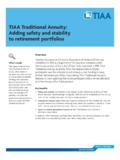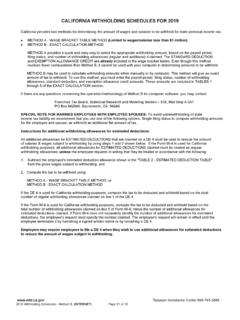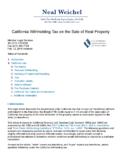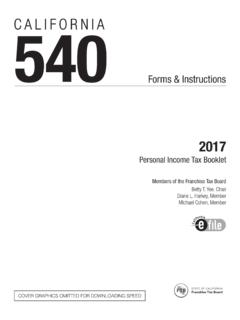Transcription of TAX RULES TO CONSIDER FEDERAL TAX WITHHOLDING - …
1 TAX WITHHOLDING RULES Page 1 of 4 F11456 (5/19)TAX RULES TO CONSIDER1. Rollover Eligible Payments are payments that can be directly rolled over to an IRA or other similar retirement plan. If you directly roll over your distribution to another account, no taxes will be There may be penalties for not paying enough FEDERAL and/or state income tax during the FEDERAL and state tax WITHHOLDING rates are always subject to TAX WITHHOLDING PERIODIC WITHDRAWALSW ithholding is voluntary from Lifetime Annuity, certain Fixed Periods, Minimum Distribution Option and other periodic payments. However, you may want TIAA to withhold taxes from your annuity payments so that you do not have to pay quarterly estimated taxes. Please consult with a tax advisor for advice on how to pay the appropriate amount of tax throughout the year to avoid any underpayment penalties imposed by the keep in mind, when FEDERAL tax WITHHOLDING is calculated, there is a minimum payment amount that must be met in order for any WITHHOLDING to take place.
2 The higher the number of allowances elected, the lower the amount of taxes will be withheld. If your election is based on marital status and a number of allowances and your payment is below the minimum threshold for WITHHOLDING , taxes will not be withheld. Each TIAA payout is considered separately when calculating the tax elections can be changed at any time by submitting a new Form W-4P or making a new election TAX WITHHOLDING CASH WITHDRAWALSCash withdrawal payments include, but are not limited to, Lump Sums, Systematic Withdrawals, dividends (unless they are used to pay premiums for the contract), and certain loans. The default WITHHOLDING RULES for cash withdrawal payments are based on whether or not the cash withdrawal is rollover eligible. TAX WITHHOLDING RULES Page 2 of 4 F11456 (5/19)MANDATORY STATE TAX WITHHOLDINGIn addition to being taxed at the FEDERAL level, pension and annuity income may also be taxed at the state level. TIAA withholds state income tax when required by state laws or regulations.
3 The states listed below require the payer of pension and annuity income to withhold state income tax based on that state s WITHHOLDING following are mandatory states: Arkansas California Connecticut Delaware District of Columbia Georgia Iowa Kansas Maine Maryland Massachusetts Michigan Nebraska North Carolina Oklahoma Oregon Vermont VirginiaAdditional mandatory state tax RULES to CONSIDER :1. If you are a resident of Connecticut and receive a lump sum distribution that brings your account balance to zero, the tax must be withheld without exception. However, Connecticut mandatory WITHHOLDING does not apply to payments to estates, trusts or other entities. If you take cash withdrawals, whether or not rollover eligible, you can elect not to have the state tax withheld or select a flat dollar amount of WITHHOLDING on the Connecticut WITHHOLDING form. If you receive periodic payments, whether or not rollover eligible, you can elect a code on the state WITHHOLDING form corresponding to the percentage of tax you want withheld (including zero).
4 2. The District of Columbia only requires mandatory WITHHOLDING on a lump sum distribution that brings your account balance to If you are a resident of Iowa and you do not make a state election and your cash payments are less than $6,000 per payment or your periodic payments are less than $500 monthly, $1,500 quarterly, $3,000 semi-annually or $6,000 annually, there will be no state WITHHOLDING . Also, you can elect no state WITHHOLDING only if you have elected no FEDERAL If you are a resident of Kansas and the distribution is from a Kansas Board of Regents plan, the distribution may be exempt from tax; therefore, you may elect to have no If you are a resident of Michigan and: You (or your spouse if filing jointly) were born prior to 1946, all benefits from public sources (as defined by the Michigan Department of Treasury) are exempt from Michigan state taxes. Benefits from private sources may be subtracted for a single filer or married filer filing separately or if married filing a joint return for the current tax year.
5 In addition, benefits that will be rolled into another qualified plan or IRA will not be taxable if the amount rolled over is not included in FEDERAL adjusted gross income (AGI). Any private pension payment in excess of Michigan income limits is taxable. You (or your spouse if filing jointly) were born during the period 1946 through 1952, a portion of all private and public pension and annuity benefits may be subtracted from Michigan taxable income. You (and your spouse) were born after 1952; all private and public pension and annuity benefits are fully taxable and may not be subtracted from Michigan taxable income. You feel your distribution is not subject to state tax, then you may elect to have no If you are a resident of North Carolina and the distribution is considered exempt under the Bailey/Emory/Patton Settlement, the distribution may be exempt from tax; therefore, you may elect to have no WITHHOLDING TAX WITHHOLDING RULES Page 3 of 4 F11456 (5/19)VOLUNTARY STATE TAX WITHHOLDINGW hile not all states require that taxes be withheld, there are several states that allow participants to have state taxes withheld voluntarily.
6 You can obtain a WITHHOLDING election form from TIAA, use the WITHHOLDING certificate from your permanent state of residence, or send a letter to TIAA identifying the percentage to be withheld if you reside in one of the following states: Alabama Arizona Colorado Idaho Illinois Indiana Kentucky Louisiana Minnesota Missouri Montana New Jersey New Mexico New York North Dakota Ohio Pennsylvania Rhode Island South Carolina Utah West Virginia WisconsinNON- WITHHOLDING STATE TAX WITHHOLDINGT here are currently eleven states that do not impose a state income tax on pension and annuity income. This means that TIAA should not withhold taxes from any of the following states: Alaska Florida Hawaii Mississippi Nevada New Hampshire South Dakota Tennessee Texas Washington WyomingAny tax information included in this written or electronic communication was not intended or written to be used, and it cannot be used by the taxpayer, for the purpose of avoiding any penalties that may be imposed on the taxpayer by any governmental taxing authority or agency.
7 TAX WITHHOLDING RULES Page 4 of 4 F11456 (5/19)Cash WithdrawalPeriodic WithdrawalRollover EligibleNon-Rollover EligibleRollover EligibleNon-Rollover EligibleTax WITHHOLDING Default RatesLump Sum or Systematic Withdrawal from a Retirement Annuity, Group Retirement Annuity, Supplemental Retirement Annuity, Group Supplemental Retirement Annuity, Retirement Choice, KEOGH, Retirement Transition Benefit, or 457(b) PublicLump Sum or Systematic Withdrawal from an IRA, Required Minimum Distribution, or After-Tax Retirement AnnuityPeriodic Payments such as Fixed Period <10 years, Interest Options, or Transfer Payout AnnuityLifetime Annuities, Minimum Distribution Option, Savings and Investments, Fixed Period > 10 years, or After-Tax Retirement AnnuitiesFederal20%10%20%Married with 3 AllowancesArkansas5%3%5%Married with 3 AllowancesCalifornia10% of FederalWithholding 10% of FEDERAL Withholding10% of FEDERAL Withholding10% of FEDERAL with 0 allowancesSingle with 0 allowancesDistrict of on full distributions, otherwise the default is no on full distributions.
8 Otherwise the default is no withholdingNo WithholdingNo WithholdingGeorgiaNo WithholdingNo WithholdingMarried with 3 AllowancesMarried with 3 AllowancesIowa5%5%5%5%Kansas5%No Withholding5%No WithholdingMaine5%5%5%Single with 0 WithholdingMassachusetts0 Exemptions0 Exemptions0 Exemptions0 with 3 AllowancesNorth Carolina4%4%Single with 0 allowancesSingle with 0 AllowancesOklahoma5%5%Married with 3 AllowancesMarried with 3 AllowancesOregon8%8%Single with 0 AllowancesSingle with 0 AllowancesVermont30% of FEDERAL Withholding30% of FEDERAL WithholdingMarried with 3 allowancesMarried with 3 AllowancesVirginia4%4%0 Exemptions 0 Exemptions
















